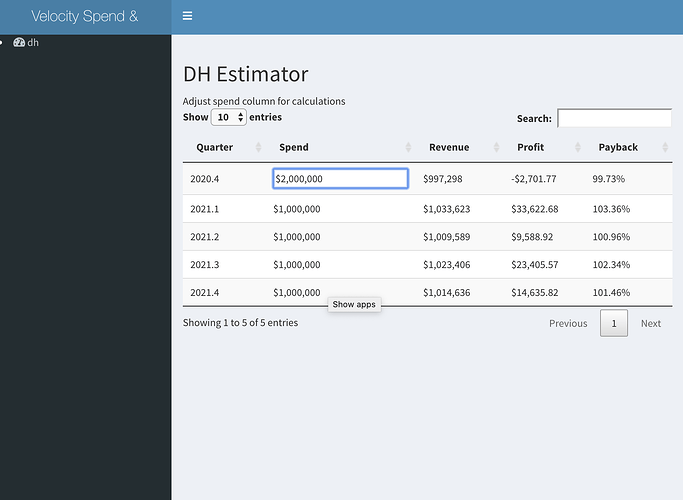The sample code block below generates a small Shiny app with a datatable.
The table shows spend, revenue and profit by quarter. The idea is that the user inputs spend amount and then the table updates with new data for revenue and profit. The new data is based on the imputed spend amount.
Here is the code to generate the app:
pacman::p_load(shiny, tidyverse, shinydashboard, lubridate, scales, DT)
# define some functions
# generates an example df based on imputed budgets
create_sample_df <- function(budgets) {
data.frame(cohort = seq('2020-10-01' %>% ymd, '2021-12-31' %>% ymd, by = '1 days')) %>%
mutate(Quarter = quarter(cohort, with_year = T)) %>%
add_count(Quarter) %>%
mutate(DailyBudget = budgets[Quarter %>% as.character] %>% unlist / n) %>%
group_by(Quarter) %>%
mutate(Revenue = DailyBudget + rnorm(n(), mean = 0, sd = DailyBudget / 5)) %>%
summarise(Spend = sum(DailyBudget),
Revenue = sum(Revenue),
.groups = 'drop') %>%
mutate(Profit = dollar(Revenue - Spend),
Payback = percent(Revenue / Spend),
Spend = dollar(Spend),
Revenue = dollar(Revenue)) %>%
mutate(Quarter = as.character(Quarter)) # do this last keep ordering of quarters
}
# render DT
render_dt = function(data, editable = 'cell', server = TRUE, ...) {
renderDT(data, selection = 'none', server = server, editable = editable, ...)
}
# UI ----
header <- dashboardHeader(title = 'Velocity Spend & Return Calculator')
HTML("Adjust spend column for calculations")
sidebar <- dashboardSidebar(
menuItem("dh", tabName = "dh", icon = icon("dashboard"))
)
body <- dashboardBody(
tabItems(
tabItem(tabName = "dh",
h2("DH Estimator"),
HTML("Adjust spend column for calculations"),
DT::DTOutput('budgets_df_dh'),
DTOutput("tb1")
)
)
)
ui <- dashboardPage(header, sidebar, body)
# Server ----
server <- function(input, output) {
# Initial budgets, will update when a user edits the spend column in the app
budgets <- list(
'2020.4' = 1000000,
'2021.1' = 1000000,
'2021.2' = 1000000,
'2021.3' = 1000000,
'2021.4' = 1000000
)
# the df to be displayed as a DT::datatable.
budgets_df <- reactive({
create_sample_df(budgets)
})
observeEvent(input$budgets_df_dh_cell_edit, {
info = input$budgets_df_dh_cell_edit
str(info)
i = info$row
j = info$col + 1
v = info$value
# update budgets, which in turn is used to generate data during create_sample_df()
budgets[[i]] <<- v %>% str_replace_all('\\$|,', '') %>% as.numeric
})
# eventually use distinct budgets for each, just demo right now
output$budgets_df_dh <- render_dt(data = budgets_df(),
rownames = FALSE,
list(target = 'cell',
disable = list(columns = c(0, 2:4))))
}
shinyApp(ui, server)
When you run the app and click tab 'dh' it should look like this:
In the screen shot I have amended the spend in the first row from 1M to 2M. In my code Spend corresponds to the list called 'budgets' and I update it within observeEvent() above budgets[[i]] <<- v %>% str_replace_all('\\$|,', '') %>% as.numeric
After budgets list has been updated I would like to recreate budgets_df based on this new budget. You can see variable budgets being referred to within the function create_sample_df().
However, when I update the spend column in the app, the fields for Revenue and profit are unchanged. Expectation and desired result are that when the spend/budget is updated, the fields to the right are also updated.
